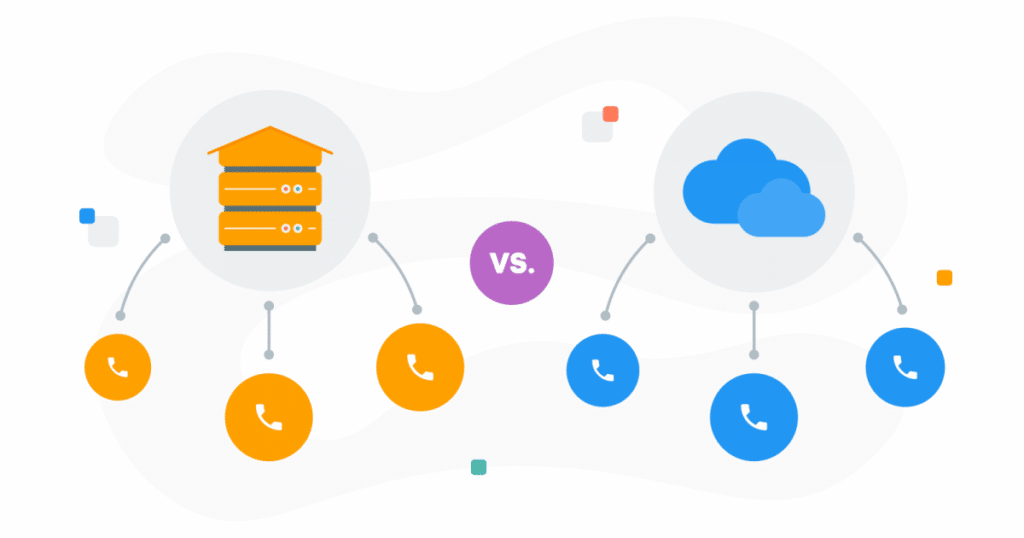On Premise vs. Cloud-Based Call Center Software: What is the difference

If you asked a call center owner ten years ago what kind of call center software they were using in their company, the vast majority of them would say “on-premises”.
It’s not like they had a lot of choices – internet connections weren’t as fast or reliable as now, so no one even dreamed about using cloud-based solutions. And while making calls through the internet was already possible, the quality of them left a lot to be desired. Besides, on-premises platforms were seen as the most secure option for any company – the only real problem was the hardware failing every now and then.
Today though, companies all around the World are swapping their old, on-premises call center platforms for cloud-based ones. Cloud solutions offer far more in terms of their flexibility, versatility, and number of features that simply cannot be matched by on-premises tools. And to boot, cloud-based solutions are also much cheaper and can be used remotely.
In this article, we’re going to compare the key factors of both on-premises and cloud-based solutions, from their reliability and flexibility to initial and long-term costs.
Learn about call center software in our buyer’s guide
The main types of call centers
Today’s call centers can be divided into two main groups: on-premises and cloud-based.
#1 On-premises solutions
On-premises solutions are the typical phone setups for companies that use phone lines installed throughout an entire building, including servers and PBX phones. All the equipment that the call center needs to make calls is stored in the building, making on-premises solutions very reliable – at least until there is a hardware failure.
It was also regarded as the safest option for a while, as there’s little chance of anyone hacking the phone system to steal data or eavesdrop on calls. Their biggest fault is that the setup is complex and expensive – it is necessary to hire an IT service team to build the infrastructure inside an office and connect everything together. And if there’s a hardware failure then it might take a while before the system is up and running again, while access to the phone lines will be lost during that time.
#2 Cloud-based call center
A cloud-based call center, meanwhile, is the exact opposite. Phone lines, servers, or any physical equipment are all unnecessary. In fact, so is a typical phone, since a laptop or tablet works here as well.
The whole infrastructure is based on the internet and calls are also made through the web using Voice Over Internet Protocol. Basically, as long as agents have access to a stable internet connection then they can make calls from anywhere. The biggest worry for companies is how secure the Cloud and VoIP are, especially with so many cybersecurity threats around. Another problem is that VoIP is very reliant on an internet connection, meaning that if it is poor or fails then making calls is impossible.
What are the differences between on-premises and cloud-based call centers? Let’s go through them one by one.
Remote-friendliness
Before the pandemic hit, many call center owners (and agents too) couldn’t even imagine working from any other place than their own office.
Everything was there – dedicated phones, the whole phone infrastructure, their customer database, a long list of computer tools, and so on. If agents were away from their office desk for whatever reason, they had no way of actually making or receiving calls. For companies with an on-premises tool stack, that turned out to be a massive problem – their offices closed, and with them so did their entire phone operations.
Here’s where cloud-based systems came to the rescue. Since they operate from the cloud rather than from one specific building, they can be used absolutely anywhere as long as there’s a stable internet connection. Whether an agent works from their home or a coffee shop, they have access to exactly the same tools and database as they had in the office. The only restriction is that the chosen place must have a stable, fast, and secure internet connection. Otherwise, a poor connection can severely impact the call quality and the agent’s productivity.
Analytics
While the number of available features in PBX systems has grown somewhat in recent years (call routing and auto attendants are pretty much standard now), they are still lagging far behind cloud systems.
For example, can you check which agent answered the most calls or which one solves most of their calls or issues during the first interaction? Can you pinpoint when exactly you have the highest amount of calls and whether or not you should add more agents to handle them? Probably not. By default, on-premises systems don’t have analytic features – you can buy them separately, but that would mean extra monthly costs on your bill.
For cloud-based platforms, detailed real-time analytical features are available from the get-go. They give you access to an enormous amount of performance data, from detailed analytics on every single call answered in your call center (e.g. duration and hold times) to performance reports for all of your agents. All metrics are displayed in a real-time dashboard and regularly updated, so you can notice any problems at a glance.
Ease of scaling up (or down)
As the number of customers calling your support line grows and your current support staff cannot manage all calls by themselves, you’ll probably consider hiring new agents. Or maybe you just need an additional agent for a week or two in order to handle some increased workload during the holidays.
Here comes the problem – you can’t add a new agent to an on-premises system that easily. You need to contact the phone provider first, order a new desktop phone, add it to your phone line, and configure it before the agent can even start working. And that’s assuming everything goes smoothly and your current server can handle the extra phone.
Cloud-based solutions are much easier to scale. First of all, you don’t need to install any additional hardware to make or receive calls before your new agents arrive. Once you add them as new users to your cloud contact center platform, they can start taking calls even from a work computer.
With how easy you can add new users to the cloud center platform comes another benefit – you can increase or decrease the number of agents as much as you need. For example, you can add additional agents just for a holiday period and remove them after the call workload reduces to normal.
Security
Fear of their system being hacked and data leaked is one of the biggest reasons why a lot of companies are still wary of cloud-based platforms.
After all, no one wants to have someone eavesdropping on their business calls or, worse, their precious customer data falling into the wrong hands. For this reason, on-premises phone systems are seen as the safest option for businesses. The risk that an unauthorized person will gain access to the server room or spy on calls is minimal, especially someone from outside of the business.
Can cloud systems give companies the same level of security, considering the ever-growing number of hacking and scamming attempts?
Yes, they can.
From the highest levels of data encryption and user authentication methods to regular scanning and testing the system for vulnerabilities, cloud platforms do everything they can in order to guarantee that data inside the system is as safe as it can be.
To ensure that your call logs, business information, and all other data is safe with us, at Cloudtalk we use a combination of security tokens and full 256-bit encryption with a Perfect Forward Secrecy system. All passwords used in the platform are also encrypted through a one-way algorithm. As for your calls, those made through both the SIP and WebRTC protocols are automatically encrypted.
Costs
Last but not least, let’s talk about the costs associated with both systems. Of the two, on-premises phone systems are generally more expensive as it is necessary to purchase equipment and hire a technician to configure everything. Plus, with each new agent, you also need to buy an additional phone for them. You need to also consider regular maintenance and repair costs, plus the price of replacing the phones once every few years.
A cloud-based system is far easier to install. You don’t need to hire an IT technician to build the infrastructure or configure the phones.
In fact, you don’t even need to buy a set of desk phones for each of your agents – they can use their office computers to make and receive calls. And the best part? You won’t just save money on the installation or equipment, but you can also save a good chunk of your budget on tools included in the package that you would otherwise have to buy separately.
Conclusion
As you can see, the benefits of a cloud-based call center far outweigh those of on-premise ones, especially in uncertain times when having a flexible solution is a must.
Besides being much easier to install and maintain, cloud-based systems are the ideal solution for call centers that plan to keep remote work as an option. Whether you need more features to make your agents work easier or cut on the costs of a regular on-premise system, CloudTalk has everything your business needs for running an efficient cloud center.




















